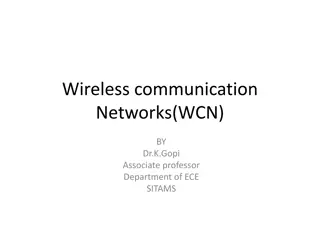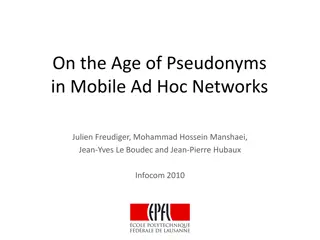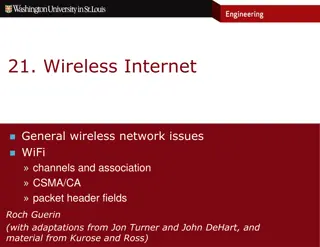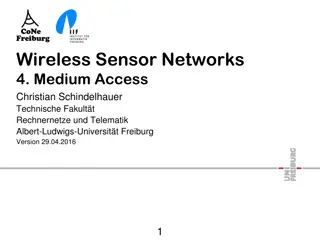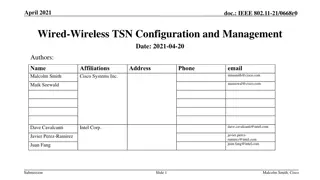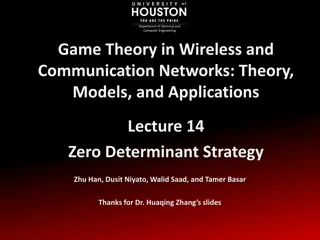Developing Attack Defense Ideas in Ad Hoc Wireless Networks
This research delves into the challenges and security threats faced by ad hoc wireless networks, particularly in the context of connected vehicles. It explores various attacks such as distributed denial-of-service, spoofing, replay, and more, and aims to measure the impact of implementing security measures on safety. The focus is on monitoring, identifying, and mitigating attacks in order to enhance the security of vehicle-to-vehicle communication systems.
Download Presentation

Please find below an Image/Link to download the presentation.
The content on the website is provided AS IS for your information and personal use only. It may not be sold, licensed, or shared on other websites without obtaining consent from the author.If you encounter any issues during the download, it is possible that the publisher has removed the file from their server.
You are allowed to download the files provided on this website for personal or commercial use, subject to the condition that they are used lawfully. All files are the property of their respective owners.
The content on the website is provided AS IS for your information and personal use only. It may not be sold, licensed, or shared on other websites without obtaining consent from the author.
E N D
Presentation Transcript
Developing Attack Defense Ideas for Ad Hoc Wireless Networks Bharat Bhargava Computer Science Department/CERIAS, Purdue University, West Lafayette, IN, USA bbshail@purdue.edu 765-413-7312
Outline 1. Motivation 2. Objectives 3. Attacks 4. Impact of Attacks on Safety 5. Impact of Implementing Security Features 5.1 Case of Study: Security vs. Safety 6. References 2
Motivation Vehicle has more than 60 sensors and 30 or more Electronic Control Units (ECUs), i.e. Brake Control, Engine Control, GPS, Airbag Control, etc [6] OBU allows heterogeneous and homogenous communications between vehicles and infrastructures (roadside equipment) CAN (Control Area Network) Bus Radio Interface or On-Board Unit (OBU) enables short-range wireless ad hoc networks to be formed 3
Motivation Connected vehicles deploy signals to communicate with other vehicles, roadside units, personal devices and cloud services Goal: provide assistance to drivers and prevent collisions Connected vehicle consists of electronic control units (ECUs) communicating via CAN (Controller Area Network) bus to transfer messages and execute queries sent from other ECUs Vehicle-to-vehicle (V2V) and vehicle-to-infrastructure (V2I) communications are prone to security threats 4
Objectives 1. Measure the cost/overhead associated with providing security in V2V communication and its impact on safety 2. Monitor, Identify, and Mitigate Attacks 5
Attacks in Ad Hoc Wireless Networks Distributed Denial-of-service Attacks Spoofing Attacks Replay Attacks Worm hole Attacks Eavesdropping Interception Masquerade Attack Malware Attack Message Tampering Collaboartive Attacks
Details of Attacks Replication attacks Adversaries can insert additional replicated hostile nodes into the network after obtaining some secret information from the captured nodes or by infiltration. Sybil attack is one form of replicated attacks Sybil attacks A malicious user obtains multiple fake identities and pretends to be multiple, distinct nodes in the system. This way the malicious nodes can control the decisions of the system, especially if the decision process involves voting or any other type of collaboration 7
Details of Attacks Denial-of-Messages (DoM) attacks Malicious nodes may prevent other honest ones from receiving broadcast messages by interfering with their radio Blackhole attacks A node transmits a malicious broadcast informing that it has the shortest and most current path to the destination aiming to intercept messages Wormhole attacks An attacker records packets (or bits) at one location in the network, tunnels them to another location, and retransmits them into the network at that location 8
Details of Attacks Denial-of-Messages (DoM) attacks Malicious nodes may prevent other honest ones from receiving broadcast messages by interfering with their radio Blackhole attacks A node transmits a malicious broadcast informing that it has the shortest and most current path to the destination aiming to intercept messages Wormhole attacks An attacker records packets (or bits) at one location in the network, tunnels them to another location, and retransmits them into the network at that location 9
Details of Attacks Rushing attacks An attacker disseminates a malicious control messages fast enough to block legitimate messages that arrive later (uses the fact that only the first message received by a node is used preventing loops) Malicious flooding A bad node floods the network or a specific target node with data or control messages 10
Protection Against Collaborative Attacks Characterizing collaborative/coordinated attacks Types of collaborative attacks Identifying Malicious activity Identifying Collaborative Attack 11
Collaborative Attacks Informal definition: Collaborative attacks (CA) occur when more than one attacker or running process synchronize their actions to disturb a target network 12
Examples of Attacks that can Collaborate Denial-of-Messages (DoM) attacks Blackhole attacks Wormhole attacks Replication attacks Sybil attacks Rushing attacks Malicious flooding We are investigating the interactions among these forms of attacks Example of probably incompatible attacks: Wormhole attacks need fast connections, but DoM attacks reduce bandwidth! 13
Current Proposed Solutions Blackhole attack detection Reverse Labeling Restriction (RLR) Wormhole Attacks: defense mechanism E2E detector and Cell-based Open Tunnel Avoidance (COTA) Sybil Attack detection Light-weight method based on hierarchical architecture Modeling Collaborative Attacks using Causal Model 14
Problem Statement Focus on collaborative packet drop attacks. Why? Secure and robust data delivery is a top priority for many applications The proposed approach can be achieved as a reactive method: reduce overhead during normal operations Can be applied in parallel to secure routing
Ideas Detecting packet drop attacks Audit based approaches Whether or not the next hop forward the packets Use both first hand and second hand evidences Problems: Energy consumption of eavesdropping Can be cheated by directional antenna Authenticity of the evidence Incentive based approaches Nuggets and credits Multi-hop acknowledgement
Proposed approach Hash based approach: S1 sends out the packet to n1: Every node will add a fingerprint into the packet S n1: (S, D, data packet, random number t0) Node n1 will combine the received packet and its random number r1 to calculate the new fingerprint: t1 = h( r1 || S || D || data packet || t0 || r1 ) n1 n2: (S, D, data packet, t1 ) The audited node will generate the bloom filter based on the data packets and the fingerprints The source will generate its own bloom filter and compare it to the value of the audited node
Impact of Attacks on Safety Miller and Valasek demonstrated in DEF CON 21 a set of attacks including very serious attacks. Hard braking/ no braking attack Locked brake Sudden stop Braking distance increase Acceleration attack Sudden uncontrollable acceleration Steering wheel attack Sudden uncontrollable rotation of a steering wheel Engine shutdown Light out attack Dashboard indication is misrepresented Dashboard indication is off 18
Impact of Deploying Security Mechanism Security Safety Data comes from a known trusted node Delay: validating undetected data Digital Signature Security depends on the key size Delay: Undetected modifications can compromise safety Encryption 19
Impact of Implementing Security Features V2V Security Safety No No attacks Do nothing security features Misleading dashboard and gps; firmware and data wiped out; compromised vehicle s sensors, part of botnet framework Under attacks Human damage, collisions, delays in traffic With security features No attacks Power consumption and computation overhead Do nothing Under attacks Isolate intruder, warn other nodes about attack, deviate attacks to targets with less damage Faster response time 20
CASE OF STUDY: SECURITY VS SAFETY Category of traffic messages: Traffic information messages: Used to disseminate the current conditions of specific areas and they indirectly affect safety General safety messages: Used for cooperative driving and collision avoidance, and require an upper bound on the delivery delay of messages Liability-related messages: Exchanged after an accident occurs 21
CASE OF STUDY: SECURITY VS SAFETY Scenario 1: Sudden stop on a highway Vehicles move to same speed on the highway Pre-determined distance between them Reaction time with and without V2V Reaction time with secured V2V High way scenario with only two vehicles involved 22
CASE OF STUDY: SECURITY VS SAFETY Stopping distance: Driver s perception time Driver s reaction time Vehicle s reaction time Vehicle s braking capability Table 1 The RSA recommended minimum stopping distance under dry conditions 23
CASE OF STUDY: SECURITY VS SAFETY System Model: Network: IEEE 802.11a compliant 6Mbps minimum Security mechanism on V2V: PKI infrastructure Every vehicle is assigned a public and private key Public key distributed through a certificated signed by the CA Authenticated message: 24
CASE OF STUDY: SECURITY VS SAFETY System Model: Security costs on V2V: Processing cost Public?Key?Cryptosystem? ECDSA? Generation?(ms)? 3.255? Verification?(ms)? 7.617? ? ? Communication cost: Distance: 120m Bandwidth: 6Mbps Speed of communication link: 3x10^8m/s 25
CASE OF STUDY: SECURITY VS SAFETY Experiment 1: Measurement of delays of V2V messages with and without security 0.0020 Message Delay [sec] V2V Communication 0.0015 V2V With Authentication V2V Without Security 0.0010 0.0005 200 300 400 500 Size of Message [bytes] Speed: 120Km/h Distance: 120m 26
CASE OF STUDY: SECURITY VS SAFETY Experiment 2: Measurement of the capacity of the link Number of message able to send in a 6Mbps lin 3000 V2V Communication V2V With Authentication 2000 V2V Without Security 1000 200 300 400 500 Size of Message [bytes] Speed: 120Km/h Distance: 120m 27
CASE OF STUDY: SECURITY VS SAFETY Experiment 3: Reaction time with V2V 0.20 Reaction time distance [m] 0.15 V2V_Communication V2V With Authentication 0.10 V2V Without Security 0.05 0.00 30 40 50 60 80 100 120 Speed in Highway [Km/h] Size of the message: 200 bytes Distance: 120m 28
CASE OF STUDY: SECURITY VS SAFETY Conclusion: Vehicular networks strictly require integrity and authentication but not confidentiality. Reaction times achieved via V2V (with or without security) are significantly smaller than a those of systems without V2V. V2V without security allows shorter reaction times than V2V with security. Lightweight cryptography must be applied to speed up processing. Alternative mechanisms for key management need to be explored. 29
References [9] P. Angin, B. Bhargava, R. Ranchal, N. Singh, L. Lilien, L. Othmane and M. Linderman. "An entity-centric approach for privacy and identity management in cloud computing." 29th IEEE Symp. on Reliable Distributed Systems, Oct. 2010. [10] R. Ranchal, B. Bhargava, L. Othmane, L. Lilien, A. Kim, M. Kang and M. Linderman. "Protection of identity information in cloud computing without trusted third party." 29th IEEE Symp. on Reliable Distributed Systems, Oct. 2010. [11] B. Bhargava, P. Angin, R. Ranchal, R. Sivakumar, A. Sinclair and M. Linderman. "A trust based approach for secure data dissemination in a mobile peer-to-peer network of AVs." Intl. J. of Next-Generation Computing, vol.3(1), Mar. 2012. [12] L. Ben Othmane and L. Lilien, Protecting Privacy in Sensitive Data Dissemination with Active Bundles, .Seventh Annual Conf. on Privacy, Security and Trust (PST 2009), Saint John, New Brunswick, Canada, Aug. 2009, pp. 202-213. [13] L. Ben Othmane, Protecting Sensitive Data throughout Their Lifecycle, Ph.D. Dissertation, Dept. of Computer Science, Western Michigan University, Kalamazoo, Michigan, Dec. 2010. [14] Lei Yao, Tao Gong, Jin Fan, Bharata Bhargava, Research on ARM9-Based Intelligent Immune System for Avoiding Rear-End Collision , Intl. Journal of Immune Computation (IC) Vol. 1, No. 1, pp. 4-8, 2013 [15] G. Izera M., A. Johnson, B. Bhargava, Secure protection methods in vehicle-to- vehicle networks , submitted, 2017 30




